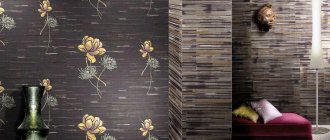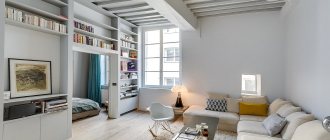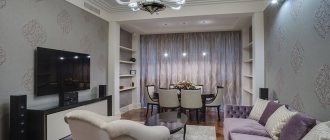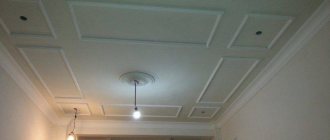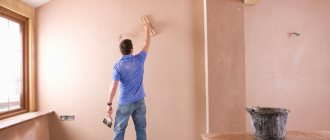No. 1. Dye
Painting walls is not only the most economical and easiest way to decorate them, but also one of the most practical. For hallway walls, latex, silicate, silicone and acrylic paints , which dry quickly and have a sufficient number of shades. The surface painted with such compositions can be washed, which can be called the key advantage of this solution. Among other advantages it is worth highlighting:
- ease of application, because even a beginner can cope with painting walls;
- huge selection of colors. For the hallway, you can choose any desired shade, combine two colors, or create a simple design. Thus, you can create a completely boring interior in the hallway. Available for sale today decorative paints, the main advantage of which is to create a unique visual effect: they can imitate any material, cast in silver or gold, change color from different angles, have a fancy pattern, etc. At the same time, decorative paints have excellent performance qualities, allowing them to be used even in the hallway;
- wear resistance and maintainability, because repainting walls by updating the shade or applying a different color is not difficult;
- if the hallway has complex architectural elements, such as niches, arches, then paint becomes one of the simplest finishing methods, because it can be applied even in the most inaccessible places;
- budget.
The only disadvantage of painting is the need to carefully prepare the surface of the walls. They must be smooth and even so that the coating on them looks neat.
No. 2. Decorative plaster
Decorative plaster allows you to create quite an interesting and unique finish: thanks to different compositions and fillers, you can get a smooth shiny surface (Venetian plaster) or a textured one. In addition to interesting decorative effects, plaster is often used in hallways due to other advantages :
- solidity of the finished coating;
- environmental friendliness and breathability;
- strength, durability and wear resistance, because scratching such walls will not be easy;
- antistatic and easy to maintain;
- It is not necessary to prepare the surface of the walls for plastering as carefully as for painting, because the solution can fill small holes and hide minor defects.
Plaster is easy to apply to non-standard architectural forms, and the hallway space will not be reduced, which is important for owners of small apartments. The only drawback is the high cost of some types of plasters, but this disadvantage is more than compensated for by durability and practicality.
Creating lighting in the room
When choosing light sources, you also need to take care of their fixation points in the corridor. The light should not be made too dim or too bright, both extremes are equally bad. It is important to avoid extremes. The level of lighting should be the same as in other rooms so that the entire apartment is decorated with light finishes combined with uniform lighting. The hallway may not have very high ceilings; in this case, it is recommended to avoid hanging lampshades, as there is a risk of getting caught, breaking or damaging them.
If the hallway is large, you can zone the space with light. When the room is small, you can highlight some parts of the space with light sources, this will allow you to use the lamps necessary in each specific case. There are usually three types of lighting in hallways:
- general;
- local;
- decorative
The first is turned on at the entrance, the second is needed to highlight certain areas, for example, a wardrobe or a mirror, but decorative lighting can decorate a room, emphasizing particularly attractive design elements.
No. 3. Microcement
Microcement is a material that has recently appeared on the construction market. Due to a number of properties, it can be classified as decorative plasters, but its outstanding performance qualities make it necessary to consider it separately. The material consists of a polymer-cement mixture to which dyes are added.
The main advantage of microcement is the ability to apply it to any substrate: such a finish will hold equally firmly on wood, concrete and metal. In addition, using microcement you can create a smooth, rough, matte or embossed surface. Thanks to the structure of the material, any color turns out natural, as it is slightly muted. A wall finished with microcement turns out to be durable, it is not susceptible to mechanical stress, so it is simply an ideal option for a hallway, especially since it is cheaper in cost than conventional decorative plasters.
No. 4. Wallpaper
Despite the existence of many types of modern finishing materials, wallpaper continues to be actively used everywhere, incl. and in the hallways. Of course, paper wallpaper is not suitable for this room, but new types of wallpaper with interesting properties have appeared, and the range has expanded so much that choosing a material that is suitable in terms of characteristics and colors is not difficult.
Wallpaper captivates us with its ease of installation, low cost, and a huge selection of shades and patterns . Among all the many types of wallpaper, the following wallpapers are suitable for the hallway:
- glass wallpaper They lead in reliability, strength, wear resistance, moisture resistance, and are not afraid of even animal claws. Moreover, it is a safe, breathable material that additionally reinforces the walls. You can paint glass wallpaper several times, each time choosing a new shade. Thanks to stencils, you can also apply drawings. Glass wallpaper can withstand the effects of any solvents, so you can apply any paint you like, but it is better to opt for washable paint, for example, latex;
- liquid wallpaper are something between wallpaper and plaster. They are distinguished by their monolithic surface, soundproofing properties and wear resistance. Walls for this type of finishing do not have to be in perfect condition, since minor irregularities are easy to disguise. Liquid wallpaper is an ideal option for arranging a hallway in a new building, since it will not crack when the house shrinks. They can be repainted, wiped clean, they do not attract dust, and if damage occurs, minor repairs are very easy to make;
- vinyl washable wallpaper They are also well suited for hallways, since dirt can be easily removed from them, and some types of such wallpaper can even be rubbed with a brush. The range of colors is huge, the price is affordable, and the main disadvantage is the inability to allow air to pass through, but more expensive wallpapers made of hard vinyl do not have this drawback;
- non-woven wallpaper , which should not be confused with vinyl wallpaper on a non-woven basis, is breathable, moisture-resistant and durable, and some of them can even be painted several times;
- quartz wallpaper not so common, but due to their combination of properties they are ideal for a hallway. They are made by applying quartz sand to a paper or non-woven base, resulting in a durable surface that is difficult to damage, but can be washed and cleaned. Such wallpapers are fire resistant, and their appearance is beyond praise. The material can be painted with latex paint, quickly updating the hallway without worrying about thoroughly preparing the surface;
- cork wallpaper Although it cannot be called an ideal option for a hallway, it is quite suitable for this room. Main advantages: naturalness, heat and sound insulation, invisibility of small scratches;
- metallic wallpaper they have good strength and wear resistance, they are elegant, but they require many nuances when gluing, and they are expensive, so they are not suitable for everyone;
- linkrusta wallpaper with a voluminous pattern will bring luxury into the hallway, and in terms of performance, it is a good material that can be washed and which only becomes stronger over the years.
By the way, with the help of color and wallpaper patterns you can visually correct some of the shortcomings of the hallway: if the area is small, you should use light wallpaper, and for low hallways, wallpaper with vertical stripes is suitable.
No. 5. Plastic panels
Plastic panels are one of the types of wall panels that are successfully used today to decorate hallways. The main advantages include:
- low price;
- a huge variety of design options, and you can choose either plain panels or materials with ornaments or imitating wood, stone, etc. At a low price you can achieve amazing visual effects;
- ease of installation and no need to level the walls;
- possibility of wet cleaning.
The disadvantages include the property of fading when exposed to sunlight. In addition, the material cannot be called the most durable: a strong blow will damage the integrity, but in normal hallway conditions the panels perform well and justify their cost.
Photos of design ideas
There are many design options and to choose the right design, you should familiarize yourself with the options for ready-made premises. You can create a partition with a combined space.
Hallway in Provence style
Rich eco-friendly hallway design
Hallway in classic style
Hallway in high-tech style - unusual and modern
Entrance hall in Baroque style
The hallway is perceived as the face of the owner of the living space, and how it looks depends on whether you want to return there. Therefore, read my article and start creating a cozy room. Good luck!
No. 6. MDF panels
MDF panels are more expensive than plastic ones, but they are more durable, environmentally friendly and look more solid. In fact, this is an alternative to wooden lining, and it is based on an MDF board, which is veneered, laminated or painted to achieve an imitation of some type of wood, leather or stone.
The main advantages of MDF panels include:
- a wide range of;
- ease of installation and maintenance;
- durability;
- environmental friendliness;
- affordable price.
When arranging a hallway in this way, it is worth taking into account the low fire resistance of the material, as well as its considerable weight and the need to then install special fastenings if you need to hang something on the wall.
No. 7. Fake diamond
Artificial stone is made from gypsum, so we can talk about the environmental friendliness and safety of the material. Modern technologies make it possible to create exact copies of natural stones such as marble, onyx, granite and many others, but at the same time they are lighter and cheaper. In terms of basic properties, artificial stone is practically not inferior to natural stone, and its advantages include:
- moisture resistance. The top layer does not allow moisture to pass through, which makes it possible to use such a finish even in bathrooms, not to mention the hallway;
- strength and wear resistance. It is difficult to damage the stone, and all drops of dirt are easily washed off with a damp sponge, while the decorative qualities of the finish remain the same;
- ease of installation;
- durability;
- fire resistance.
The disadvantages of stone include its not the lowest cost, so often it is not used to decorate all the walls in the hallway, but only their lower parts and doorways: this way, decent savings are achieved, and the most dangerous parts of the walls will be reliably protected. You can combine decorative stone with paint or plaster.
Mirror wall
A solid mirrored decorative wall looks very impressive in the hallway.
- It creates an interesting play of light, transforms the space and visually expands it.
- This design is suitable for most modern styles.
The room will seem much lighter, airier and brighter, and there will even be a feeling of coolness. The effect will be enhanced if the interior is decorated in light shades.
No. 8. Flexible stone
Flexible stone has only recently appeared on the market, so it has not yet gained sufficient popularity, and many simply do not know about its existence and benefits. This is a natural material that can even be used for finishing facades, which indicates strength, resistance to wear and moisture. A flexible stone based on sandstone is produced, which is applied to fiberglass. In this way, finishing material is obtained in the form of slabs and wallpaper, the main advantages of which are:
- environmental friendliness and harmlessness;
- ease of installation;
- resistance to moisture and fire;
- ease of care;
- durability. Experts say that the material will last at least 35 years;
- Since flexible stone is plastic, it can take on completely unexpected configurations, thanks to which the most unexpected solutions can be realized.
The only downside is the price, which remains at the level of natural stone, but you have to pay for durability and exceptional performance.
Features of hallway decoration
To prevent a small room from seeming overloaded, you should carefully select finishing materials, furniture, and colors. There is no natural light in the apartment corridors, so it is better to give preference to a light palette and glossy surfaces. Such simple solutions will help present the room favorably and visually increase its area.
Walls, floors, ceilings and doors should be in harmony. The hallway is closest to the front door of all rooms and is more often exposed to various types of pollution, cold, and damage. If there are animals in the house that need to be regularly walked, or small children, special attention should be paid to the flooring.
The decoration of the hallway is usually done last, when the renovation of all living rooms of the apartment or house is completed. This is due to increased traffic, the movement of large furniture and contamination at the time of refurbishment. Repair of the corridor should be carried out with wear-resistant finishing materials, taking into account their frequent cleaning.
No. 9. Ceramic tile
Yes, we are all accustomed to associating ceramic tiles with a bathroom or kitchen, but this material, if selected successfully, will fit perfectly into the interior of the hallway, and there is no need to talk about its excellent performance qualities. Among the main advantages of ceramic tiles it is worth highlighting:
- a huge assortment, so choosing the material of the desired color and with a certain pattern will not be difficult;
- practicality, resistance to scratches, moisture and temperature changes;
- strength;
- durability.
Today, manufacturers offer a huge selection of ceramic tiles: they can even imitate wood, stone or leather, therefore, fit perfectly into the interior of the hallway. Moreover, for some interior styles, tiles are the main decorative element. So, it will look great in a hallway in Provence or country style, and it is not at all necessary that all the walls be tiled - it is important that their lower part is well protected.
Color selection
The choice of wall cladding shade depends on a number of factors:
- styling of the hall;
- the degree of its illumination;
- taste preferences of the owners.
It is better to choose colors that do not stain, but if it was decided to decorate the hallway with light panels or plaster, then the materials should be reliably protected with varnish, special impregnation or other finishing agents.
When choosing a color scheme, you need to proceed from the interior style of the hallway, the degree of illumination and area. If the corridor is small and dark, the surfaces should be light. If you have a large space in the hall, you can not limit your imagination by choosing any shades.



